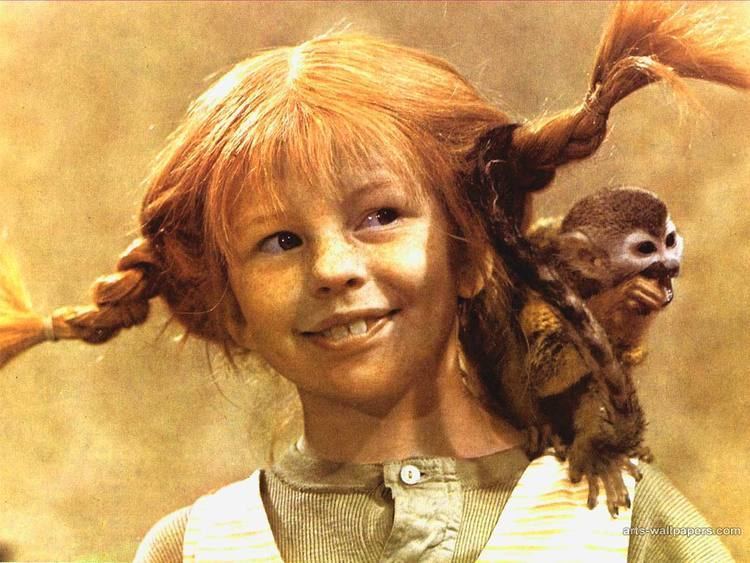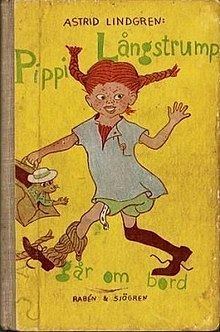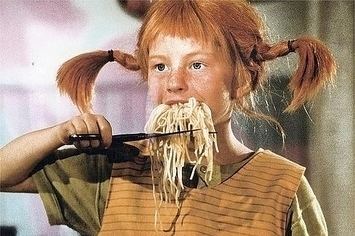Nickname(s) Pippi First appearance Pippi Longstocking (1945) | Gender Female Movies and TV shows Pippi Longstocking | |
 | ||
Played by Inger Nilsson, Tami Erin, Melissa Altro, Viveca Serlachius, Susan Davis Similar Madicken, Karlsson‑on‑the‑Roof, Mr Nilsson, Bill Bergson, Bamse | ||
Pippi Longstocking (Swedish: Pippi Långstrump) is the main character in an eponymous series of children's books by the Swedish author Astrid Lindgren. Pippi was named by Lindgren's daughter Karin, then nine years old like Pippi, who asked her mother for a get-well story when she was off school.
Contents
- Setting
- Personality
- Father
- Strength
- Books
- The 1949 movie
- The 1961 Shirley Temples Storybook episode
- The 1969 television series
- The Soviet television film
- The ABC Weekend Special TV special
- The American feature film
- Nelvanas Pippi Longstocking franchise
- Hayao Miyazakis cancelled anime film
- Name
- Legacy
- References

Pippi is red-haired, freckled, unconventional and superhumanly strong – able to lift her horse one-handed. She is playful and unpredictable. She often makes fun of unreasonable adults, especially if they are pompous and condescending. Her anger comes out in extreme cases, such as when a man ill-treats his horse. Pippi, like Peter Pan, does not want to grow up. She is the daughter of a buccaneer captain and has adventure stories to tell about that too. Her four best friends are her horse and monkey, and the neighbours' children, Tommy and Annika.

After being rejected by Bonnier Publishers in 1944, Lindgren's first manuscript was accepted by Rabén and Sjögren. The first three Pippi chapter books were published in 1945–48, another six in 1969–75, and two final stories in 1979 and 2000. They have been translated into 70 languages and made into several films and television series.

Setting

Pippi lives in a small Swedish village, sharing the house she styles "Villa Villekulla" with her monkey named Mr. Nilsson, and her horse (nameless in the books; the horse has names in adaptations, most notably "Lilla Gubben", Swedish for "little old man" – other names include Horatio, Alfonso, and Horse) but no adults or relatives. She befriends the two children living next door: Tommy and Annika Settergren. The three have many adventures. Tommy and Annika's mother, Mrs. Settergren, often disapproves of Pippi's manners and lack of education, but Mrs. Settergren eventually comes to appreciate that Pippi would never put Tommy and Annika in danger, and that Pippi values her friendship with the pair above almost anything else in her life. Pippi's two main possessions are a suitcase full of gold coins (which she used to buy her horse) and a large chest of drawers containing various small treasures.
Personality
Pippi is portrayed as being a friendly and kind girl, but one with no "proper" manners and having no training or experience in how to behave in normal society, that is, any society other than the very freewheeling and non-regimented one aboard her father's ship. Due to leading a life at sea, Pippi has received very limited conventional education. This is balanced by the fact that she seems to have a wide range of competency in housekeeping skills; she demonstrates that she can cook for herself, clean and repair her house, care for her pets, and otherwise manage her affairs despite her illiteracy and lack of mathematical knowledge. Her behavior is highly exasperating to many adults, but she enjoys sharing recollections of her memories of sailing across the world. Pippi tends to tell many "tall tales" about her travels but appears to do so for the purpose of entertainment and will admit to her untruths when questioned. Otherwise she seems trustworthy and loyal to her friends.
Father
Pippi is the daughter of a South Seas seafarer Ephraim Longstocking, captain of the sailing ship Hoptoad (Hoppetossa in Swedish), from whom Pippi inherited her common sense and incredible strength. Captain Longstocking is the only person known to match Pippi in physical ability. He originally bought Villa Villekulla to give his daughter a more stable home life than that on board the ship, although Pippi loves the seafaring life and is a better sailor and helmsman than most of her father's crew.
Pippi retired to the Villa Villekulla after her father was believed lost at sea, but Pippi was determined in her belief that her father was still alive, had rescued himself to an island, had been made a king of the natives, and was strolling around all day with a crown on his head. She believed her father would one day come to look for her at Villa Villekulla.
As it turned out, Captain Longstocking had been washed ashore upon a South Sea island known as Kurrekurredutt Isle, where he was made the "fat white chief" by its native people. The Captain returned to Sweden to bring Pippi to his new home in the South Seas, but Pippi found herself attached to the Villa and her new friends Tommy and Annika, and decided to stay where she was, though the children sometimes took trips with her father aboard the Hoptoad, including a trip to Kurrekurredutt, where she was confirmed as the "fat white chief's" daughter, Princess Pippilotta. In the Swedish original, Pippi is described as "negerprinsessa" and her father as "negerkung", meaning "negro princess" and "negro king" respectively.
Strength
Pippi has been described as "the strongest girl in the world", but no explanation is given for her strength. Pippi's strength amazes and confounds people, including the children, though they eventually begin to take it in stride. Pippi herself makes no mention of her extraordinary strength, though she is obviously aware of it. She is not at all violent, and when circumstances require her to protect herself or others, she usually takes great care not to hurt anyone. This is seen in the first book, when she neutralizes five large bullies singlehandedly, and also when she engages two policemen, who were determined to take her to an orphanage against her will, in a game of tag.
She is also seen in the various Pippi Longstocking movies picking up a horse (the books often mention Pippi moving her horse Old Man by carrying him from one place to another), a car, and weights/barbells weighing over 1,000 pounds; she also pulls bars out of a jail window and throws pirates across a room.
Books
There are three full length Pippi Longstocking books:
There were three original picture books that were translated into English:
There are many picture books and short books based on chapter excerpts from the original three including:
The 1949 movie
The first movie adaptation of Pippi Longstocking was filmed in 1949. The film was based on three of the books, but several storylines were changed and characters were removed and added. Pippi's character was played by Viveca Serlachius, who as Pippi made 10 other movies between 1944 and 1954. It was directed by Per Gunvall and released on October 20, 1950.
The 1961 Shirley Temple's Storybook episode
In 1961, the American children's anthology TV series Shirley Temple's Storybook (hosted by Shirley Temple) included an adaptation of Pippi Longstocking, Episode 2-15, aired on January 8. This was the first American adaptation of Astrid Lindgren's character, not to mention the first adaptation done in color, and the first to feature a child actress playing Pippi—in this case, former Mousketeer Gina Gillespie. Gillespie also plays a girl named Susan Scholfield, who appears at the beginning and end of the story with her younger sister Betsy (played by Gina's sister Jennifer), both dreaming up the whole story after being sent to bed early. Although the story is mostly faithful to the original books, a few liberties are taken; Pippi is shown to be extremely intelligent (flawlessly answering a strict but well-meaning teacher's questions), which she attributes to her firsthand experiences in her world travels, and Pippi can fly (rather, she lands softly onto the ground from the rooftop of her house, à la Peter Pan). Among the characters, Pippi's originally nameless pet horse is named Horatio, and Thunder-Karlsson and Bloom are renamed "Scar Face" Seymour and "Mad Dog" Jerome. Also of note is Swedish wrestler/actor Tor Johnson, in one of his final roles, playing a circus strongman, the Mighty Adolf, whom Pippi challenges to a match of strength at the circus.
The 1969 television series
A Swedish Pippi Longstocking television series was created based on the books in 1968. The first episode was broadcast on Sveriges Radio TV in February 1969. The production was a Swedish-West German co-production and several German actors had roles in the series.
As Astrid Lindgren was unhappy with the 1949 adaptation, she wrote the script herself for this version. The series was directed by Olle Hellbom who also directed several other Astrid Lindgren adaptations. Inger Nilsson gave a confident, oddball performance that was uncommonly consistent and eccentric for a child actress.
This version is the most well-known version in Sweden and has been repeated numerous times by SR/SVT. In other European countries this is the most favoured version of Pippi Longstocking.
The Swedish series was re-edited as two dubbed feature films for United States distribution:
Another two feature film spin-offs were also shown in the United States:
They became weekend television staples in several cities in the United States throughout the 1970s and 1980s. The first 6 episodes of the original TV series, newly dubbed using British actors, became available on DVD in 2002.
The Soviet television film
A Mosfilm television film version, Peppi Dlinnyychulok, was released in 1984. It was produced by Margaret Mikalan, and starred Mikhail Boyarsky, Lev Durov and Tatiana Vasilieva. Pippi was played by Svetlana Stupak, and her singing voice was provided by Svetlana Stepchenko.
The ABC Weekend Special TV special
In 1985, Carrie Kei Heim played the title role in the 2-part ABC Weekend Special, entitled Pippi Longstocking. Directed by veteran special effects wizard Colin Chilvers, Part 1 of the special aired on November 2, and Part 2 aired on November 9.
The American feature film
An American feature film version from Columbia Pictures was released in 1988, directed by British veteran director Ken Annakin, starring Tami Erin as Pippi with Eileen Brennan, Dennis Dugan, John Schuck and Dick Van Patten in supporting roles. While the title suggests a continuation, the film is in fact just a retelling of the original story. The original songs and the score were composed by Misha Segal.
Nelvana's Pippi Longstocking franchise
An animated film adaptation by Nelvana, Pippi Longstocking, was released in 1997 and was adapted into an animated television series, Pippi Longstocking by Nelvana, which aired for one season (1997) on Canada's Teletoon channel and later (1998) on HBO in the United States. Reruns are shown on the Qubo digital subchannel. While the movie used traditional animation, the series used the digital inking process.
Hayao Miyazaki's cancelled anime film
In 1971, Japanese animators Hayao Miyazaki and Isao Takahata had expressed great interest in doing an anime feature adaptation of Pippi Longstocking. The proposed project was titled Pippi Longstocking, The Strongest Girl in the World (長靴下のピッピ 世界一強い女の子, Nagakutsushita no Pippi, Sekai Ichi Tsuyoi Onna no Ko). They traveled to Sweden, and not only did research for the film (they went location scouting in Visby, one of the major locations where the 1969 TV series was filmed), but also personally visited creator Astrid Lindgren, and discussed the project with her. After their meeting with Lindgren, however, their permission to complete the film was denied, and the project was canceled. Among what remains of the project are watercolored storyboards by Miyazaki himself.
Name
The original Swedish language books set Pippi's full name as Pippilotta Viktualia Rullgardina Krusmynta Efraimsdotter Långstrump, which contains some words that cannot be translated directly. English language books and films about Pippi have given her name in the following forms:
As of 2009, the book has been translated into 64 languages. Here are the character's names in some languages other than English.
Legacy
The Swedish town of Vimmerby, Lindgren's hometown, has a theme park based on the Pippi Longstocking series of books. Scenes from the book are recreated at one-third scale, and actors roam the park dressed as Pippi and other characters.
The most popular children's festival in Slovenia, annually held in Velenje since 1990, is named Pika's Festival after Pippi Longstocking.
Swedish author Stieg Larsson, in writing his Millennium series, has stated that one of the main characters in the three novels, Lisbeth Salander was fashioned on a grown-up Pippi Longstocking. In the only interview he ever did about the series, Larsson stated that he based the character on what he imagined Pippi Longstocking might have been like as an adult.
Pippi appears on the obverse of the Swedish 20 kronor note. The note, released in October 2015, also features a portrait of Lindgren and a motif of Småland, Sweden, the province in which she grew up.
